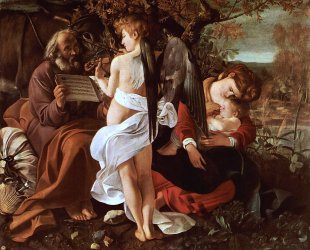Compared to the elegant intimacy and historical import of the diptychs in the infancy narrative of St. Luke’s Gospel, the briefer infancy story in St. Matthew’s Gospel has a legendary and even exotic tone. The fulfillment of five different prophecies, together with five dreams, structures the narrative, with Joseph as the central agent and protector of the Holy Family against the murderous King Herod. The story of “magi from the East” searching for “the newborn King of the Jews,” which serves as the first act of Matthew’s second chapter, has enchanted readers and artists through the ages. So has the second act, with its interrelated scenes of the flight into Egypt, the slaughter of the Holy Innocents, and the Holy Family’s return from Egypt.
 Of these last scenes, the flight into Egypt has been particularly popular. The Incarnation Window of the cathedral of Chartres’s West Front (c. 1155–60) depicts it with delicate simplicity. Duccio painted it on the predella of his Maestà for the cathedral of Siena (1308–11). With luminous economy, Fra Angelico’s version at San Marco in Florence (c. 1450) shows Mary and the infant Jesus mounted on a donkey guided by the intrepid Joseph (see left).
Of these last scenes, the flight into Egypt has been particularly popular. The Incarnation Window of the cathedral of Chartres’s West Front (c. 1155–60) depicts it with delicate simplicity. Duccio painted it on the predella of his Maestà for the cathedral of Siena (1308–11). With luminous economy, Fra Angelico’s version at San Marco in Florence (c. 1450) shows Mary and the infant Jesus mounted on a donkey guided by the intrepid Joseph (see left).
In time, legendary material from noncanonical sources, especially the Gospel of Pseudo-Matthew (fourth to eighth century), came to figure regularly in depictions of the flight. The Metropolitan Museum of Art in New York boasts a marvelous example, a polychromed, high-relief sculpture of The Miracle of the Palm Tree on the Flight into Egypt by an unknown Castilian artist (c. 1490–1510). Here, slightly smaller than life-size figures of the family have paused beneath a palm tree bending to feed them at the command of the child Jesus (who appears to be three or four). Cradled in his mother’s lap, he looks into the distance, serene in his authority. Mary, riding a docile donkey and wearing an elaborate cloak with a gold border, glances sideways at him, while a vigorous young Joseph reaches up for the golden dates. (Two wingless angels peer down on the event.) In remarkable condition, the piece has folkloric immediacy and narrative élan—but also dynamic refinement, increased by the empty spaces between the figures and the bending tree.
 Succeeding generations of artists rejoiced in the pictorial possibilities of the theme, with “the rest on the flight” taking particular prominence. Joachim Patinir (c. 1480–1524) painted elaborate landscapes around that central event—and is often considered the father of landscape painting. Caravaggio (1571–1610) invented a scantily clad angel to play the violin for the family, with an elderly Joseph dutifully holding the score (see right). Rubens (1577–1649) would imagine the scene as a garden of love, and Rembrandt (1606–69), capitalizing on the escape’s nighttime setting, gave us one of his greatest nocturnal canvases. By the time of Giambattista Tiepolo (1696–1770) and his son Domenico (1727–1804), the repertoire of legendary material led to entire suites of drawings elaborating on the three terse verses of Matthew’s Gospel.
Succeeding generations of artists rejoiced in the pictorial possibilities of the theme, with “the rest on the flight” taking particular prominence. Joachim Patinir (c. 1480–1524) painted elaborate landscapes around that central event—and is often considered the father of landscape painting. Caravaggio (1571–1610) invented a scantily clad angel to play the violin for the family, with an elderly Joseph dutifully holding the score (see right). Rubens (1577–1649) would imagine the scene as a garden of love, and Rembrandt (1606–69), capitalizing on the escape’s nighttime setting, gave us one of his greatest nocturnal canvases. By the time of Giambattista Tiepolo (1696–1770) and his son Domenico (1727–1804), the repertoire of legendary material led to entire suites of drawings elaborating on the three terse verses of Matthew’s Gospel.
The art has often been sublime, but the theology less so. For the flight was by no means an idyllic excursion, accompanied by attendant angels and effecting the destruction of idols. It was a poor young family’s desperate escape from a tyrant king who is portrayed, realistically if not with exact historicity, as ordering the slaughter of all the male children of Bethlehem. Joseph, “the child and his mother” fled as refugees to Egypt—a place of shelter and abundance, but one with ambiguous significance for the people of Israel. The journey can only be imagined as perilous in the extreme. Once arrived, how could Joseph have cared for “the child and his mother” except as a migrant worker? What food, what shelter, what hope would there have been for them at first?
Unless we appreciate the desperation of this moment in Matthew’s story, we cannot grasp the full import of the family’s being called “out of Egypt.” In fact, this is the story of a new exodus: As Moses, saved from Pharaoh’s wrath, later led his people from persecution toward a promised land, so Jesus escapes Herod but returns as the Messiah of his people—king in a far truer sense than Herod could ever be. Not that he returns immediately in glory: his ministry of redemption germinates for many years. When he enters upon it, he finds not only disciples but also ardent enemies who will eventually drag him to an agonizing death “outside the city.”
The flight into Egypt thus foreshadows the full humiliation that Jesus would experience on the Cross. And to whom can it speak more directly than to the millions upon millions of immigrants, refugees, and displaced persons in today’s world? (The United Nations High Commission for Refugees counts 15.2 million refugees and 51 million internally displaced persons.) Their plight—of displacement, homelessness, lack of sure shelter, disruption of family life, abusive treatment—is a plight shared in his first days by the child born to be their Savior.
There have been artists who have imagined the Holy Family’s flight as part of Jesus’ true incarnation, his sharing of everything human but sin. With raw, direct emotion, African Americans such as Henry Ossawa Tanner (1859–1937) and James Lesesne Wells (1902–93) recognized the flight as a situation that their people could understand immediately as their own. One of Tanner’s favorite themes (he treated it at least fifteen times), the flight is represented with almost mystical intensity in a version owned by the Metropolitan that shows the Holy Family setting out at night alone and unprotected but for a guide, whose lantern lights their way among darkening blue shadows.
Perhaps a still more apt image, though not a directly biblical one, is an Eastman Johnson painting that shows a father, mother, and child in flight on a horse by the dull light of dawn. The horse at full gallop, the young family’s tense faces all in profile, the roughly painted ground beneath them, all convey a sense of intense alarm and fear. Titled A Ride for Liberty—The Fugitive Slaves (c. 1862), the picture represents an event Johnson witnessed near the battlefield of Manassas as a family fled from the Confederate lines to the Union side. What better image could there be of hope for freedom from servitude?
We may delight in the artistic invention of countless “Flights into Egypt.” But we should watch to see where brothers and sisters of Jesus are today in flight—and humbly remember, in our celebration of God-with-us, that he too left his homeland, as a child and then as an adult, while seeking an everlasting home for us all.

